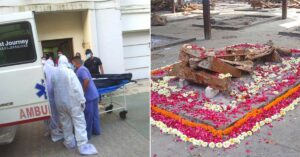Air India Pilots Save 370+ Lives, Avert Tragedy After Multiple Flight Systems Fail!
"We're really, you know, stuck and there's no fuel," Palia told the JFK Air Traffic Control (ATC). The aircraft had 370 passengers on board and tried to land at the airport but had failed.

A major tragedy on the Air India flight AI 101 Delhi-JFK (New York) was averted, thanks to the composure and presence of mind shown by senior commander Rustom Palia and second-in-command, Captain Sushant Singh.
The direct flight from Delhi to New York is one of the longest in the world. After flying for 14 hours, the pilots realised that weather conditions were deteriorating at the airport and their own system in the nine-year-old Boeing 777-300 was failing.
“We’re really, you know, stuck and there’s no fuel,” Palia told the JFK Air Traffic Control (ATC).
The aircraft had 370 passengers on board and tried to land at the airport but had failed, so they had to keep the plane airborne, in an attempt to find an airport near JFK or in a different city near New York, in coordination with the JFK ATC.
As their fuel was running out, the gravity of the situation increased.

The pilots were approaching one of the most critical phases of flying–landing–while the AI 101 system was failing, and fast.
“We have some onboard instruments problem, and because of that we are not able to conduct the ILS (Instrument Landing System) for JFK, and now we are sitting for [an] alternate for what we can do…” the pilots told JFK.
“Basically, we’ve got a single source radio altimeter, we have a Traffic Collision and Avoidance System failure… No Auto-land, no wind shear systems, (no) Auto Speed Brake and the Auxiliary Power Unit is unserviceable as well,” Palia said over the radio.
In addition to this, the ILS also failed. There are three ILS’ on the Boeing 777-300. All three malfunctioned.

“Your Instrument Landing System is out of service on both sides of the aircraft, right?” ATC asked.
“Yea, that’s correct,” responded the pilot, calmly.
The situation was enough to cause panic in any pilot–even an experienced one. But Palia and Singh remained composed. They needed to.
“And you said your radio altimeters are out on both sides of the airplane?”
“Uh, that right, we are on a single radio altimeter now,” said the pilots.
You may also like: Meet the Karnataka Girl Who Just Became South India’s 1st Woman Fighter Pilot
At that point, the fuel in the plane was 7,200 kg, being used with every passing minute. The pilots could not risk taking a longer route or staying airborne for a long time. It would have meant risking the lives of all 370 passengers and crew.
At such a crucial point, the pilots decided to attempt a ‘non-precision’ approach and use the functional navigation aids at their disposal.

According to NDTV, this means that they had to use Vertical and Lateral Navigation Systems to simulate an Instrument Landing Approach into Newark.
In Newark, at the time, the clouds were beginning to clear and so, the pilots decided to land there–their safest bet.
The challenge was that Air India does not train its pilots to use a non-precision approach and neither does Boeing mention it in its operational guidelines for the aircraft.
You may also like: Ghatkopar Crash: Pilots Steered Away From Homes, Saved Lives at Cost of Own!
However, the descent began, one that was certainly a risk, considering the gap in the training of the pilots–but at that point, it was the best option Palia and Singh had at their disposal. The Newark Airport informed the pilots that they were getting low on the approach. Within 38 seconds of the announcement, the flight was landed.
After 38 minutes of being airborne in turbulent weather, with a failing jet system and the risk of fuel running out, pilots Rustom Palia and Sushant Singh ensured that all 370 passengers on board landed safely. If not for the composed manner in which they handled the situation, many lives would have been lost.
(Edited by Shruti Singhal)
Like this story? Or have something to share?
Write to us: [email protected]
Connect with us on Facebook and Twitter.
This story made me
- 97
- 121
- 89
- 167
Tell Us More
We bring stories straight from the heart of India, to inspire millions and create a wave of impact. Our positive movement is growing bigger everyday, and we would love for you to join it.
Please contribute whatever you can, every little penny helps our team in bringing you more stories that support dreams and spread hope.



















